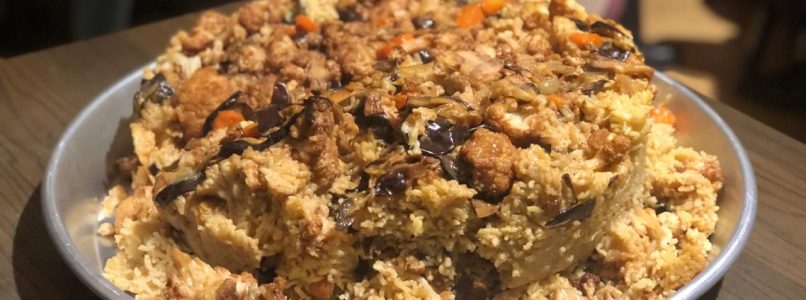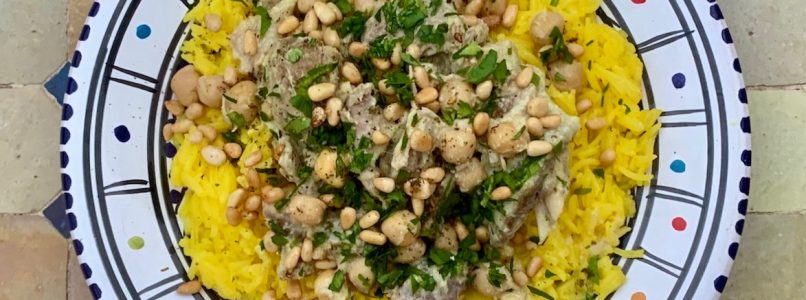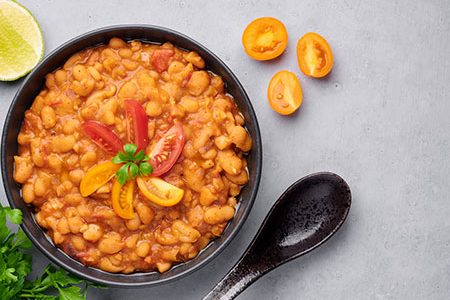In Palestinian homes, rice with chicken and vegetables is often prepared, which has a peculiarity: that of being overturned shortly before its consumption
To eat the maqloubeh no special occasions are needed. In Palestine, in fact, it is one of the most popular specialties in homes, especially on feast days, Fridays, also because everyone likes it, it varies according to the seasons and is so easy to prepare that it is known to be the ideal dish for who does not want to cook. If it were not for a fundamental step: the final one which is also at the origin of the name.
What is the maqloubeh
Maqloubeh in Arabic means overturned, upside down, overturned. This is, in fact, the main feature of this dish: the fact that, a few moments before being eaten, it is turned upside down on a large plate and then brought to the table. They are always moments of suspense, crucial moments in which the diners give an ovation, since it is not at all easy to turn the pot in that world. Indeed, it often happens that the rice falls apart. But no problem, it will be good all the same, since in addition to the shape there is great substance: the maqloubeh, in fact, is always prepared with excellent basic ingredients, usually taken fresh at the nearest market, which vary according to the season. Basically it is rice with chicken (or even red meat), spices and seasonal vegetables, so in the summer it is made more with aubergines and tomatoes, while in the winter with cauliflowers. It can also be done with fish, more on the sea, towards Gaza, or with chickpeas, especially in the Nablus area. But like all home-made dishes, there are countless different versions. We have chosen to rely on Fidaa Abuhamdiya who, among other things, has created with a friend a Facebook page, Maqluba, entirely dedicated to a sort of ironic competition on who best spills the maqloubeh without leaving a trace inside the pot.
Fidaa Abuhamdiya and "Pop Palestine Cuisine"
There is perhaps no better person than Fidaa, a native of Hebron, to talk about maqloubeh, as she is a deep lover and connoisseur of traditional Palestinian cuisine. But it is not just passion: Fidaa, in fact, has studied both nutrition and catering for a long time; then he attended various cooking classes at the Notre Dame in Jerusalem and even participated in the television program Chef Palestine. She later moved to Italy to deepen her other great passion: Italian cuisine. She worked in the starred restaurant Le Calandre and graduated in Science and Culture of Gastronomy and Catering at the University of Padua with a thesis on Palestinian cuisine. But that's not all: he also holds a master's in community nutrition and food education and today works as a blogger and chef for local and international projects. In this intense journey full of life he met many people, including another traveler passionate about Palestinian history and culture, Silvia Chiarantini, and photographer Alessandra Cinquemani. The result was a wonderful, highly engaging book: Pop Palestine Cuisine, a real journey into Palestinian popular cuisine, from Hebron to Ramallah, up to Jericho, Nablus and Jenin. To remind us that in Palestine there is a life beyond war, beyond military occupation, checkpoints. And also a cuisine that is not from the field, but is at home.
The recipe for maqloubeh
We offer you the original recipe with chicken, in its summer version with aubergines and tomatoes. But, as anticipated, it can also be prepared with other types of meat or with chickpeas; so what is not escaped is the final moment of the "overturn"!
Ingredients for 6 people
500 g of rice, 6 chicken pieces, 2 large aubergines (or 1 cauliflower if winter), 3 tomatoes, 1 head of garlic, 2 bay leaves, cardamom to taste, turmeric to taste, nutmeg to taste, black pepper to taste, to taste extra virgin olive oil, seed oil to taste, sea salt, white yogurt, whole or sliced toasted almonds.
Method
1. Rinse the rice in cold water, soak it for about an hour, then rinse it.
2. Cut the aubergines into slices, arrange them on a baking tray, sprinkle them with salt, and let them drain. After an hour they are ready to be fried, so fill a large pan with seed oil or light olive oil and fry the aubergines.
3. Arrange the chicken in a pan with the olive oil and spices, and bake at 200 ° for about an hour. Alternatively, you can also cook it in a pot with water, onion, bay leaf and spices for about 40 minutes with the lid on over low heat.
4. After the cooking time, remove the remaining broth from the pot and place it in a separate saucepan, along with a little water, as you will have to use it later for the final cooking.
5. Arrange the chicken pieces in a saucepan, add the aubergines and tomatoes to cover the base of the pan well (they will then be on top of the rice once the dish is turned upside down). Then add the rice, well rinsed and strained.
6. Add the hot broth, the sauce from the cooking of the chicken and the hot water with turmeric and black pepper to cover the entire contents of the pan (be careful not to add too much, as long as the liquid reaches the limit of the rice).
7. Cook over high heat until boiling, then reduce heat to low and cover with a lid. For good cooking, it is important that the lid fits snugly against the pan. This dish must cook completely indoors and over very low heat for about 20 minutes, then lift the lid to check that the water has dried and that the rice is cooked. If not, keep the pot on the stove for a few more minutes.
8. When the rice is cooked, remove the pan from the heat and, always with the lid on, let the contents rest for about 10 minutes.
9. We have thus arrived at the moment of overthrow. Place a tray or a very large serving dish on the edge of the pot and turn it over, overturning quickly and deftly. Tap the top and sides with a wooden ladle so that the rice comes off well, then lift the pot and your maqloubeh is ready.
10. Before presenting the dish to your guests, you can decorate as you like with chopped parsley, pine nuts or almonds, whole or sliced, browned first in a pan. Finally, serve with plain yogurt, crunchy pickles and Arab salad.
And while you prepare this dish, listen to some songs by Kadim Al Sahir, ambassador of Arabic song in the world, so you will feel a little like being in that wonderful land that is Palestine.


